The Optical Microscope Market is estimated to be valued at USD 2.8 billion in 2025 and is projected to reach USD 4.8 billion by 2035, registering a compound annual growth rate (CAGR) of 5.8% over the forecast period.
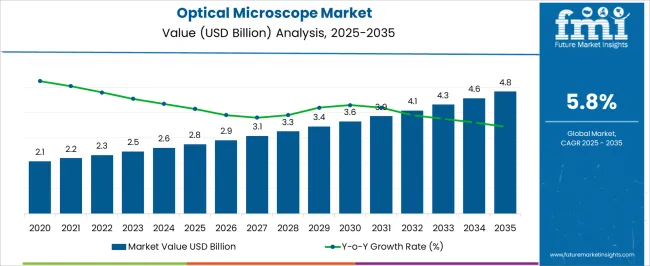
| Metric | Value |
|---|---|
| Optical Microscope Market Estimated Value in (2025 E) | USD 2.8 billion |
| Optical Microscope Market Forecast Value in (2035 F) | USD 4.8 billion |
| Forecast CAGR (2025 to 2035) | 5.8% |
The Optical Microscope market is experiencing steady growth driven by increasing demand for high-resolution imaging and precision observation across research, industrial, and educational sectors. Advancements in optical technologies, including enhanced lens quality, digital integration, and automation capabilities, are shaping the market landscape. Current adoption trends indicate that laboratories and commercial research facilities are prioritizing instruments that offer adaptability, software-enabled analysis, and compatibility with multiple imaging techniques.
The future outlook is influenced by the rising importance of microbiology, materials science, and semiconductor research, which require high-precision optical microscopy. Investments in research infrastructure, coupled with expanding applications in biotechnology and life sciences, are expected to further support market growth.
The integration of digital imaging and connectivity features allows seamless data capture, storage, and sharing, reducing reliance on traditional observation techniques As academic, industrial, and clinical research continues to expand globally, optical microscopes are projected to maintain their central role in scientific exploration, with opportunities for growth in modular, software-enhanced, and high-throughput systems.
The optical microscope market is segmented by lenses, products, application, end use industry, and geographic regions. By lenses, optical microscope market is divided into Single and Multiple. In terms of products, optical microscope market is classified into Digital Microscope, Inverted Microscope, Stereo Microscope, and Others. Based on application, optical microscope market is segmented into Microbiology, Microelectronics, Nanophysics, Biotechnology, Pharmaceutical Research, and Others. By end use industry, optical microscope market is segmented into Academics, Pharmaceutical, Chemical, and Other Industrial. Regionally, the optical microscope industry is classified into North America, Latin America, Western Europe, Eastern Europe, Balkan & Baltic Countries, Russia & Belarus, Central Asia, East Asia, South Asia & Pacific, and the Middle East & Africa.
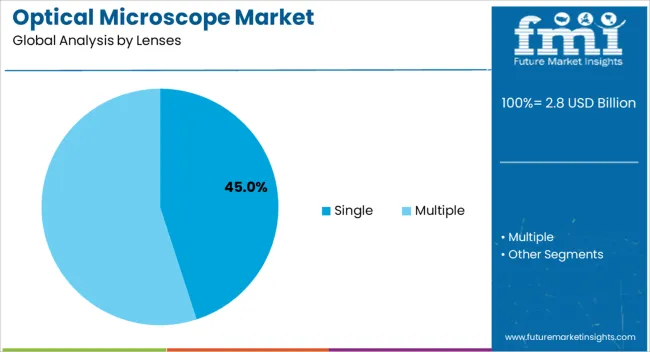
The Lenses segment is expected to hold 45.0% of the Optical Microscope market revenue share in 2025, making it the leading product type. This prominence is being driven by the critical role of high-quality lenses in achieving superior resolution and optical clarity. Single lenses are widely adopted in both educational and professional settings due to their simplicity, durability, and ability to deliver consistent performance across multiple applications.
The growth of this segment has been reinforced by the increasing demand for precise imaging in research laboratories and clinical diagnostics. The modular design of single lenses allows for flexible adaptation to different microscope configurations without requiring extensive hardware changes.
Additionally, the demand for portable and bench-top instruments has further favored single lenses because of their compact form factor and ease of maintenance As research institutions and industrial users prioritize efficiency and accuracy, single lenses are anticipated to remain a dominant choice due to their proven reliability and high optical performance.
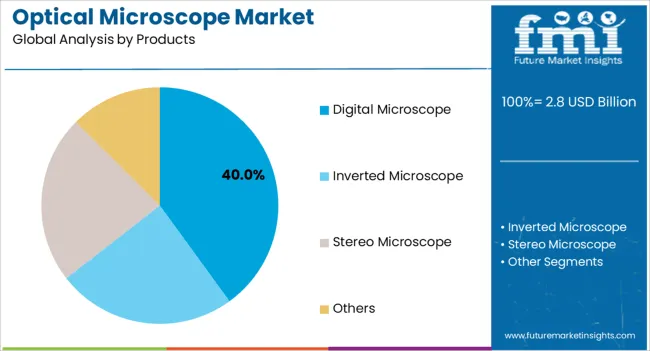
The Digital Microscope product segment is projected to account for 40.0% of the total Optical Microscope market revenue in 2025, establishing it as the leading product offering. The segment’s growth is being driven by the ability of digital microscopes to integrate software-based analysis, real-time imaging, and connectivity features, which allow seamless data sharing and collaboration.
Digital microscopes offer superior capabilities for documentation, automated measurements, and image processing, making them highly suitable for industrial, clinical, and educational applications. The increasing trend toward virtual learning and remote laboratory environments has further accelerated adoption of digital microscopy solutions.
Additionally, the compatibility of digital microscopes with advanced imaging software allows users to perform enhanced analysis without relying solely on manual observation, reducing human error and improving efficiency The widespread demand for high-precision imaging systems in microbiology, materials testing, and quality control is expected to sustain the growth of digital microscopes, solidifying their position as a key product segment in the Optical Microscope market.
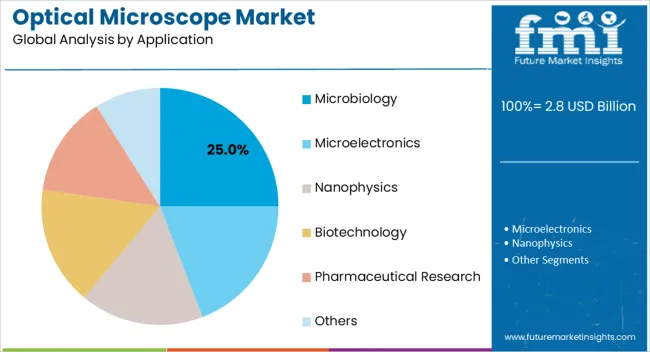
The Microbiology application segment is expected to hold 25.0% of the Optical Microscope market revenue in 2025, making it the leading end-use application. This prominence is being driven by the critical need for precise imaging and observation in microbial research, clinical diagnostics, and laboratory testing. The growth of this segment has been reinforced by the increasing focus on infectious disease research, biotechnology development, and microbial ecology studies.
Laboratories and research facilities are adopting optical microscopes with high-resolution lenses and digital imaging capabilities to ensure accurate detection, identification, and analysis of microorganisms. The integration of software tools for image analysis, documentation, and reporting further supports the efficiency of microbiology applications.
Additionally, the rising emphasis on laboratory automation and high-throughput analysis has increased reliance on optical microscopy for rapid and reproducible results As global research and clinical demands continue to expand, the Microbiology segment is anticipated to remain a primary driver of optical microscope adoption, benefiting from both technological advancements and growing scientific requirements.
The investigation of a small object and biological structure through the instrument is called a microscope. The microscope is used to see very fine particles (particle size of 1µ m and below) which are not seen by the naked eye. Microscopy is an advanced technology in the science, where, small images of the sample are visible in light with the help of single or multiple lenses.
The optical microscope is one of such instrument which is used to study these small objects or cells. Optical microscope are also labeled as light microscope. Optical microscope is widely used to view living or dead samples. In the working of an optical microscope, it produces a micrograph with standard light and sensitive camera to magnify small images of the object.
With the enhancement in the technology, an optical microscope can deliver more precise images in a short period of time. Originally, the optical microscope is used an only single lens and recently optical microscope uses more than two lenses. The expansion of microscope beam of laser light to make use of optical lenses is the innovative principle technique involved in an optical microscope.
Optical microscope is considered to be an important tool for the study of cell biological structure in the coming future
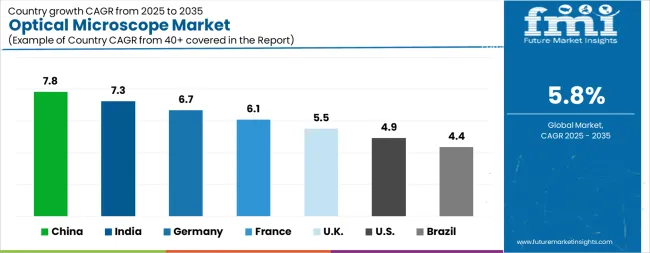
| Country | CAGR |
|---|---|
| China | 7.8% |
| India | 7.3% |
| Germany | 6.7% |
| France | 6.1% |
| UK | 5.5% |
| USA | 4.9% |
| Brazil | 4.4% |
The Optical Microscope Market is expected to register a CAGR of 5.8% during the forecast period, exhibiting varied country level momentum. China leads with the highest CAGR of 7.8%, followed by India at 7.3%. Developed markets such as Germany, France, and the UK continue to expand steadily, while the USA is likely to grow at consistent rates. Brazil posts the lowest CAGR at 4.4%, yet still underscores a broadly positive trajectory for the global Optical Microscope Market. In 2024, Germany held a dominant revenue in the Western Europe market and is expected to grow with a CAGR of 6.7%. The USA Optical Microscope Market is estimated to be valued at USD 1.0 billion in 2025 and is anticipated to reach a valuation of USD 1.6 billion by 2035. Sales are projected to rise at a CAGR of 4.9% over the forecast period between 2025 and 2035. While Japan and South Korea markets are estimated to be valued at USD 149.8 million and USD 83.1 million respectively in 2025.
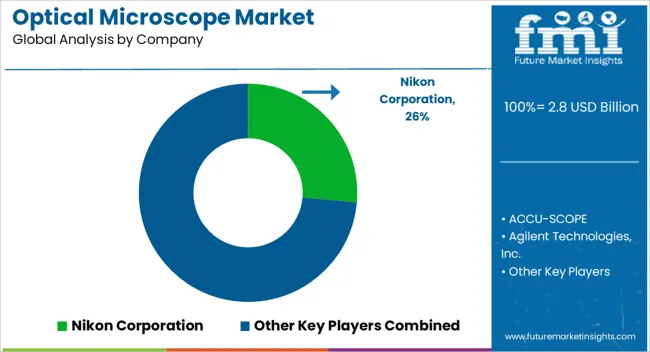
| Item | Value |
|---|---|
| Quantitative Units | USD 2.8 Billion |
| Lenses | Single and Multiple |
| Products | Digital Microscope, Inverted Microscope, Stereo Microscope, and Others |
| Application | Microbiology, Microelectronics, Nanophysics, Biotechnology, Pharmaceutical Research, and Others |
| End Use Industry | Academics, Pharmaceutical, Chemical, and Other Industrial |
| Regions Covered | North America, Europe, Asia-Pacific, Latin America, Middle East & Africa |
| Country Covered | United States, Canada, Germany, France, United Kingdom, China, Japan, India, Brazil, South Africa |
| Key Companies Profiled | Nikon Corporation, ACCU-SCOPE, Agilent Technologies, Inc., Bruker Corporation, Carl Zeiss AG, Celestron, LLC, Danaher Corporation, Hitachi High-Tech Solutions Corporation, Meiji Techno, and Olympus Corporation |
The global optical microscope market is estimated to be valued at USD 2.8 billion in 2025.
The market size for the optical microscope market is projected to reach USD 4.8 billion by 2035.
The optical microscope market is expected to grow at a 5.8% CAGR between 2025 and 2035.
The key product types in optical microscope market are single and multiple.
In terms of products, digital microscope segment to command 40.0% share in the optical microscope market in 2025.






Our Research Products

The "Full Research Suite" delivers actionable market intel, deep dives on markets or technologies, so clients act faster, cut risk, and unlock growth.

The Leaderboard benchmarks and ranks top vendors, classifying them as Established Leaders, Leading Challengers, or Disruptors & Challengers.

Locates where complements amplify value and substitutes erode it, forecasting net impact by horizon

We deliver granular, decision-grade intel: market sizing, 5-year forecasts, pricing, adoption, usage, revenue, and operational KPIs—plus competitor tracking, regulation, and value chains—across 60 countries broadly.

Spot the shifts before they hit your P&L. We track inflection points, adoption curves, pricing moves, and ecosystem plays to show where demand is heading, why it is changing, and what to do next across high-growth markets and disruptive tech

Real-time reads of user behavior. We track shifting priorities, perceptions of today’s and next-gen services, and provider experience, then pace how fast tech moves from trial to adoption, blending buyer, consumer, and channel inputs with social signals (#WhySwitch, #UX).

Partner with our analyst team to build a custom report designed around your business priorities. From analysing market trends to assessing competitors or crafting bespoke datasets, we tailor insights to your needs.
Supplier Intelligence
Discovery & Profiling
Capacity & Footprint
Performance & Risk
Compliance & Governance
Commercial Readiness
Who Supplies Whom
Scorecards & Shortlists
Playbooks & Docs
Category Intelligence
Definition & Scope
Demand & Use Cases
Cost Drivers
Market Structure
Supply Chain Map
Trade & Policy
Operating Norms
Deliverables
Buyer Intelligence
Account Basics
Spend & Scope
Procurement Model
Vendor Requirements
Terms & Policies
Entry Strategy
Pain Points & Triggers
Outputs
Pricing Analysis
Benchmarks
Trends
Should-Cost
Indexation
Landed Cost
Commercial Terms
Deliverables
Brand Analysis
Positioning & Value Prop
Share & Presence
Customer Evidence
Go-to-Market
Digital & Reputation
Compliance & Trust
KPIs & Gaps
Outputs
Full Research Suite comprises of:
Market outlook & trends analysis
Interviews & case studies
Strategic recommendations
Vendor profiles & capabilities analysis
5-year forecasts
8 regions and 60+ country-level data splits
Market segment data splits
12 months of continuous data updates
DELIVERED AS:
PDF EXCEL ONLINE
Optical Fiber Cold Joint Market Size and Share Forecast Outlook 2025 to 2035
Optical Spectrum Analyzer Market Size and Share Forecast Outlook 2025 to 2035
Optical Extinction Analyzer Market Size and Share Forecast Outlook 2025 to 2035
Optical Character Recognition Market Forecast and Outlook 2025 to 2035
Optical Satellite Market Size and Share Forecast Outlook 2025 to 2035
Optical Imaging Market Size and Share Forecast Outlook 2025 to 2035
Optical Whitening Agents Market Size and Share Forecast Outlook 2025 to 2035
Optical Fingerprint Collector Market Size and Share Forecast Outlook 2025 to 2035
Optical Lens Materials Market Size and Share Forecast Outlook 2025 to 2035
Microscope Digital Camera Market Size and Share Forecast Outlook 2025 to 2035
Optical Component Tester Market Size and Share Forecast Outlook 2025 to 2035
Optical EMI Shielding Adapters Market Size and Share Forecast Outlook 2025 to 2035
Optical Connector Polishing Films Market Size and Share Forecast Outlook 2025 to 2035
Optical Transmitter Market Size and Share Forecast Outlook 2025 to 2035
Optical Telephoto Lens Market Size and Share Forecast Outlook 2025 to 2035
Optical Lattice Clock Market Size and Share Forecast Outlook 2025 to 2035
Optical Grade Lithium Tantalate Wafers Market Size and Share Forecast Outlook 2025 to 2035
Optical Grade LiTaO3 Crystal Substrate Market Size and Share Forecast Outlook 2025 to 2035
Optical Brighteners Market Size and Share Forecast Outlook 2025 to 2035
Optical Liquid Level Sensor Market Size and Share Forecast Outlook 2025 to 2035

Thank you!
You will receive an email from our Business Development Manager. Please be sure to check your SPAM/JUNK folder too.
Chat With
MaRIA